An important stage in the installation of plastic windows design of window openings. Slopes for ...
|
|
Kaleo Trade company produces and implements an infrared film floor ... |
A huge number of construction stores are working in large cities that are full of ... |
Insulation of the house with polyurethane foam

The scope of use of polyurethane foam is quite wide, but most often it is used in the process of insulation of the house. There are several technologies by which it is possible to insulate the house using this material. We will talk about the features of each of them further.
Table of contents:
- House insulation with polyurethane foam: Features and advantages of the material
- Insulation of facades with polyurethane foam: Technology and process features
- Self -insulation of walls with polyurethane foam
- Ways to insulate the roof polyurethane foam
- How to warm the house with polyurethane foam: calculations
House insulation with polyurethane foam: Features and advantages of the material
Polyuertan foam is called the highestly effective thermal insulation material, due to its positive physical characteristics. The scope of use of polyurethane foam is quite extensive. It is used in the production of refrigeration equipment, fittings and even in the automotive industry. In addition, the use of polyurethane foam in construction is widespread. Material costs for its installation are paid off after three years of operation.

Among the main advantages of polyurethane foam, we highlight:
- good adhesion with any type and shape of the surface;
- the possibility of falling into any container;
- speed and ease of work;
- the formation of a holistic coating on which there are no joints leading to the formation of cold bridges;
- In the process of filling the polyurethane foam, a dense homogeneous layer is formed;
- high duration of operation, which is at least 35 years, subject to all requirements and norms for polyurethane foam;
- wide temperature mode of operation, from -50 to 140 degrees Celsius;
- the presence of a very low thermal conductivity coefficient;
- resistance in front of the fungus, mold, insects and various kinds of biological organisms;
- fire safety is explained by the resistance of the material before fire;
- Polyuertan foam has a low absorption of moisture, since a protective film is formed on its surface, after drying out;
- The correct application of polyurethane foam allows us to ensure a high and long period of adhesion, especially relevant in the process of insulation of pipelines;
- the material has high resistance before mechanical damage;
- polyurethane foam is non -toxic and safe material;
- This insulation is resistant to various kinds of acids and alkalis.
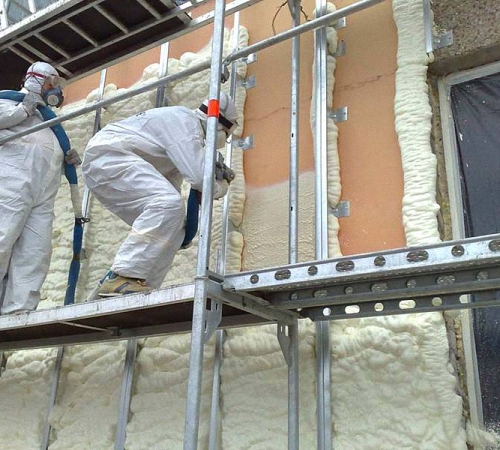
If we compare the pros and cons of polyurethane foam, then in the process of insulation there are more advantages than disadvantages. In addition to all these advantages of this material, it is an excellent sound insulator, has high strength and individual application manner. This material is characterized by high adhesion with metal, concrete, wood, plastic and stone. He is able to fill the smallest parts of the surface. With the help of spraying from polyurethane, it is possible to protect the steel areas of the house from corrosion. The insulation is unequal for rats, mice and other insects.
To cover all the surfaces of the house, both on the outer and in the inside, one day is enough. Despite this, there are shortcomings of the use of polyurethane foam as a heater. The very first of them is a fairly high cost of insulation of wooden, brick or frame buildings. It is possible to independently carry out work, without the involvement of specialists, however, equipment for applying polyurethane foam should still be purchased or rented.
Independent work requires knowledge of the technology of applying polyurethane foam and special skills in working with it.
Poliuretan foam photo:
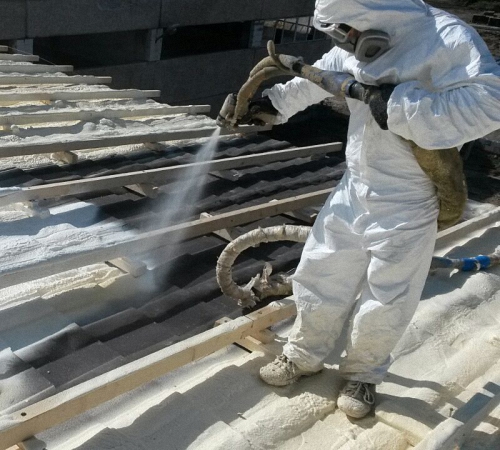
After applying polyurethane foam to the wall, it should be protected from direct ultraviolet radiation, since it is destroyed under its influence.
In addition, after applying polyurethane foam to the wall, it is impossible to install siding or other type of finish on it, which requires fixation on the wall using fasteners. If siding is installed, then dowels or screws will destroy the integrity of the wall decoration, which means that they will appear in them with cold bridges, leading to an increase in thermal losses and the formation of condensate.
After applying polyurethane foam outside, the plaster is most often used or ventilated facades are equipped. Please note that all of the above advantages of polyurethane foam are relevant only if the intricacies of its installation are observed. Work with unprofessional equipment negatively affects the quality of insulation.

Insulation of facades with polyurethane foam: Technology and process features
High -quality thermal insulation of the facade of the house can significantly reduce its heating costs, therefore, special attention should be paid to this process. Polyiuretan foam is quite common when warming the facades, primarily because of its strength and reliability. The use of thermal insulation based on polyurethane foam avoids such troubles as dampness, excess moisture, fungus and mold. The technology of insulation of the facade with polyurethane foam consists primarily in its uniform application on the surface and distribution on it. Therefore, the material is applied using a certain kind of devices that allow it to evenly distribute it on the surface.
After applying the material, its rapid increase in volume occurs, all cracks or empty areas are instantly filled with a layer of insulation. In addition, there is a formation of an even, seamless coating. Poliuretan foam has the highest adhesion with most modern building materials, so they are insulated with various kinds of facades: wooden, steel, concrete, brick, etc.
Keep in mind that the time for work, compared with other types of insulation, is quite small. In addition, the material freezes very quickly, which allows the next day the facade finish.
After thermal insulation, it is recommended to immediately carry out finishing work, since the material is unstable before ultraviolet radiation. It is possible to decorate with brick, stone, facade paint, plaster and other materials.
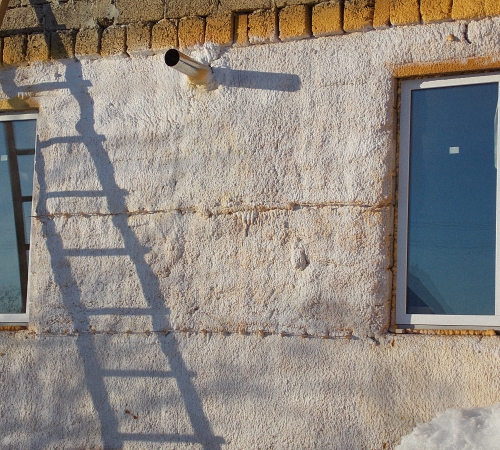
Polyiuretan foam on the surface of the facades is capable of lasting from 20 to 30 years, so using it as a heater will allow you to get a high -quality, reliable, durable coating that provides reliable thermal insulation.
Self -insulation of walls with polyurethane foam
The process of wall insulation using polyurethane foam is two types:
- internal insulation;
- External insulation.
The first option is widespread in the process of insulation of the walls of apartments in multi -storey buildings. Most often, polyurethane foam is applied to such problem areas as corners, rooms, with a strong effect and cold, loggia, etc.

Insulation of the kitchen or bath using polyurethane foam is also possible, because this material has excellent moisture -resistant characteristics. Although there is a vapor barrier, in this case, it is worthwhile. A vapor barrier with a foil coating is installed on top of the polyurethane foam, the foil side should be indoors. The high quality of the work of this system is also ensured by the presence of the correct ventilation system in the room.
In addition, with the help of polyurethane foam, attic, loggias and balconies are insulated. In this case, it is an excellent material for reducing thermal losses. External insulation of polyurethane foam is characteristic of low -rise buildings, and the procedure for conducting it consists of such elements:
- cleaning and preparing the base for applying insulation;
- conducting polyurethane foam;
- installation of reinforcement using a special screed;
- finish execution.
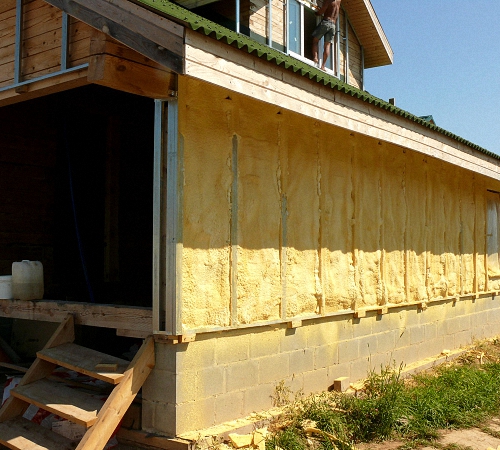
The first stage involves cleaning the walls of dirt, dust, old coatings. This procedure will significantly improve adhesion between the wall and thermal insulation material. Please note that thermal insulation of polyurethane foam does not need to pre -align the walls, unlike other thermal insulation materials.
Foaming polyurethane foam is carried out on prepared walls. The thickness of the layer depends on the type of walls and preliminary calculations for heat loss. In addition, even if the walls were uneven, their leveling is provided by polyurethane foam. Next, the walls are covered with a reinforcing layer in the form of a fiberglass mesh, on which there are small holes.
The minimum thickness of the reinforcing layer is 5-6 cm. Keep in mind that during the work you need to observe special caution, since the polyurethane foam, getting on extraneous objects, is practically not washed, even with the help of the diluent.
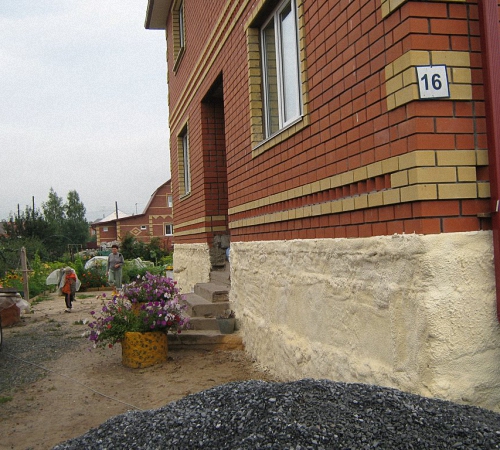
Ways to insulate the roof polyurethane foam
Before studying the technology of roof insulation using polyurethane foam, we propose to get acquainted with its main varieties used in the process of performing work. There are two options for polyurethane foam used in the roof insulation:
- polyurethane foam elastic structure;
- Hard material.
The first option has a porous structure, inside which there is oxygen or carbon dioxide. This material has a low density. The choice of this material allows us to provide not only thermal insulation, but also the soundproofing of the building.
In the second option, there is a closed -skinned structure, three percent of the material contains a dense substance, and the rest of the composition - gas. The material has a high density and is widespread in the construction industry.
Most often, in the process of warming the roof, polyurethane foam plates are used, their use is distinguished by the following advantages:
- lack of deformation when exposed to optimal loads;
- moisture resistance - protection of the roof from moisture;
- reduction in the general value of thermal losses of the building;
- environmental safety and harmless health;
- decrease in the cost of heating the building;
- convenience and ease of installation;
- good soundproofing properties;
- The slight weight of the material helps to reduce pressure on the walls and the foundation.

In addition, insulation of the roof of polyurethane foam does not need to completely analyze the entire structure. Since a small area is enough for applying the material, through which it will fall under the pressure on the entire insulated surface.
It is not necessary to carry out preliminary work on preparing the surface for insulation. The material has high adhesion with a warm surface. To apply the composition, an installation for polyurethane foam is used, so there is no need for trimming, and there is no material.
There are two ways to perform roof insulation using polyurethane foam:
- spraying;
- Pouring.
To perform the first method, it is necessary to have special equipment and skills in working with it. It is this unit that sprays polyurethane foam on the roof. Thus, it is possible to apply the material to the surface with a density of 33 to 60 kilograms per cubic meter. If there is a need, repeated application of polyurethane foam is carried out with a higher density. This double spraying method is used in the process of insulation of the roof of a complex configuration. In addition, it is possible to provide a reliable degree of protection of the roof from external influences.
Another option is possible - pouring polyurethane foam preliminary foaming. To do this, you should make a hole, and submit the material to it until the hole is completely filled.
This method is used in the process of insulation with polyurethane foam wooden houses. In this case, insulation is carried out on the attic, using a foamed heat insulator, it is possible to reliably heat the roof pie. As a result, a design with high heat and soundproofing characteristics is obtained.
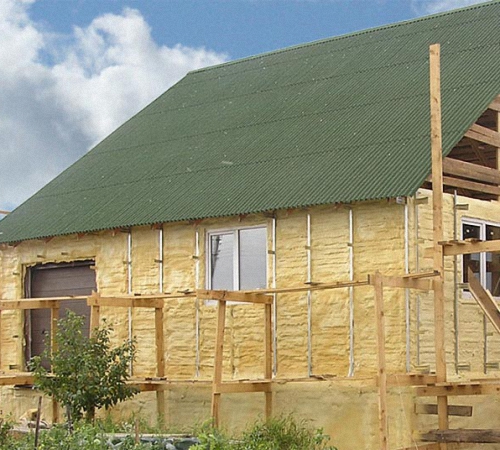
The filling method is suitable for processing any surfaces, including complex shapes. Pouring is capable of thermal insulation of various kinds of niches, protrusions, arches, columns and other designs. Poliuretan foam in this case is the most convenient material for insulation. In addition, this method is suitable for the restoration of roofs of old buildings. Polyuertan foam is able to penetrate the smallest cracks and prevent heat losses carried out through them. In addition, the thickness of the layer is adjusted manually.
How to warm the house with polyurethane foam: calculations
In order to calculate the cost of material and insulation work, you should first determine the number of polyurethane foam. To do this, calculate the thickness of the layer with which it will be applied.
For example, in order to insulate a roof, the area of \u200b\u200bwhich is about 45 square meters, you will need to apply polyurethane foam with a layer of 6-10 cm. If the area of \u200b\u200bthe insulated surface is more than 50 square meters, then the layer thickness will be smaller from 3 to 7 cm.
In the process of insulation of the house, heat loss should also be taken into account, the presence of energy -saving double -glazed windows, the number of windows and doors, the material from which the walls are made.
Poliuretan foam video:
